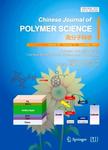Self-assembly Induced by Complexation of Diblock Copolyelectrolytes and Oppositely Charged Homopolymers
作者机构:Beijing National Laboratory for Molecular SciencesKey Laboratory of Polymer Chemistry and Physics of Ministry of EducationCenter for Soft Mater Science and EngineeringCollege of Chemistry and Molecular EngineeringPeking UniversityBeijing100871China Beijing National Laboratory for Molecular SciencesCollege of Chemistry and Molecular EngineeringPeking UniversityBeijing100871China
出 版 物:《Chinese Journal of Polymer Science》 (高分子科学(英文版))
年 卷 期:2024年第42卷第9期
页 面:1321-1332,I0006页
核心收录:
学科分类:081704[工学-应用化学] 07[理学] 070304[理学-物理化学(含∶化学物理)] 08[工学] 0817[工学-化学工程与技术] 0703[理学-化学]
基 金:supported by the National Natural Science Foundation of China(NSFC)(Nos.22073002 51921002 and 22373008)
主 题:Self-assembly Polyelectrolyte complexation Self-consistent field theory Ion-pair
摘 要:We investigate the solution self-assembly of a mixture of positively charged homopolymers and AB diblock copolymers,in which the A blocks are negatively charged,and the B blocks are *** electrostatic complexation between oppositely charged polymers drives the formation of many ordered *** microstructures and phase diagrams are calculated using self-consistent field theory(SCFT)based on an ion-pair model with an equilibrium constant K to characterize the strength of binding between positively and negatively charged *** effects of the charge ratio,representing the ratio of charges from the homopolymer over all charges from polymers in the system,on the ordered structure are systematically studied,both for hydrophobic and hydrophilic A *** charge ratio plays an important role in determining the phase boundaries in the phase diagram of salt concentration versus polymer *** also provide information about the varying tendency of the domain spacing and core size of the spherical phase when the charge ratio is changed,and the results are in good agreement with *** studies provide a deep understanding of the self-assembled microstructures of oppositely charged diblock copolymer-homopolymer systems.



